South Africa — Johannesburg: Long history, new constitution, hope and fear
This are pictures and stray memories from one amazing week in Johannesburg (South Africa). I got reminded again of how amazing Couchsurfing is, staying with friends in a strange city. And the history of racial and colonial struggles was certainly a suitable end to my time in Africa.
My first hosts recommended the Constitution Hill to me, and this was my very first activity. I realized I didn’t know a thing about the place I had gone to, really, but at least the museum guide had fun with me. And it was a one-on-one tour, too, even tough a public one. I was just the only visitor… This first picture is a nice summary of Johannesburg: On the left part of the old prison complex where black and other political prisoners were kept (among them Gandhi, more on him below). On the right the new Constitutional Court, written in all the eleven (!) official languages. And in the background the Hillbrow Tower, which had been decorated with a football for the world cup — and then repainted for a gay pride parade that took place while I was there. Old meets new in so many ways…
The museum was nicely made, this is me watching an introductory film, also all by myself. And the setup of the prison cells, which featured a strict hierarchy among the prisoners. The „bosses“ in the back, their special servants on the right, and the lowest ranks sleeping on the left literally like sardines in a can — alternately upside down, of course many more than in the demonstration.
The first sign shows the formal discrimination at the time, where white prisoners were awarded luxuries like a mattress, bedsheets and a pillow, while „non-whites“ were considered ok with „two sleeping mats and three blankets“. On the right Mahatma Gandhi, who to my surprise spent seven months imprisoned here, and many more years fighting for the rights of Indian people in South Africa (and, sadly, yes: mostly for them, largely ignoring the black’s even worse situation as far as I know).
Another touching museum exhibit: In the fight against Apartheid Gandhi’s direct political opponent was Jan Smuts, Prime Minister at the time and strong believer in racial separation. They must have both considered each other formidable enemies, for Gandhi made these sandals for Smuts while in prison, and the latter wore them proudly for 25 years. And went on to be a central figure for the establishment of both the League of Nations and the UN. How complex people are!
Now, I wasn’t alone in the museum all the time. This is a smartly dressed group of students on visit.
On into the Constitutional Court, which also tries to connect to the long history of South Africa. The leaf-shaped things on the ceiling reference traditional „African“ jurisdiction under the big tree in the village. And the bricks on the left and the staircase on the right are again preserved from the prison.
Transparency is the leading architectural theme of the court itself, again alongside traditional features like the cow skins which have something to do with one of the relevant tribes of the country. The composition of the judges sounded incredibly progressive by the way, with a blind man as well as an openly gay and HIV-positive one, and a number of women. I felt really proud to pose there with the flag. And the guide wouldn’t let me sit in one of the chairs.
The impressive wooden doors have symbols for the articles of the constitution. And the hallways has a grounding image after the elation of seeing the court and hearing about the constitution: Whites visiting the court, a black man cleaning the floor. Sadly, pretty symbolic if the life I witnessed.
This is pretty representative of the „inner outskirts“ of Johannesburg, fairly new but ugly buildings, balanced by a lot of green space for the proximity to the city center.
Also fairly symbolic: The huge car park. No way to use this city without one. And on the top of the list of improving lives in CBD, the central business district, is: Safety and Security.
The university is in this spirit a well-protected little castle where you get in only with a card that electronically opens the gate. Or a nice chat with the guy there (being white presumably helps with that). Formally, you need some sort of visitor’s pass … The picture shows how peaceful life indeed is in there.
Some of the means used to get peacefulness in your own home. There is a certain aesthetic in the rainbow-colored spikes. And a lot of sadness.
The city center: Old house, glass house, mosque and police. Further out the famous stadium, built on the site of a former mine, and using this remnant for advertising.
Also there almost too many allusions to all sorts of „traditional“ things, but looks nice.
So does the city viewed from its highest skyscraper.
And offers glimpses like this (currently or formerly) „occupied“ house. A whole different occupation from the punk-hippie one in Europe. Here, you have a big crime landlord with his own military police and an entry system as strict as the contemporary university one’s. He’ll also tap the city’s electricity for you and make sure nobody comes to disconnect. But he doesn’t care about the trash… The next picture reveals even older history, where blacks and whites couldn’t sleep in the same house. But you needed those black workers if something broke in your house in the night, and couldn’t always wait for somebody to find them in their shantytown. So: Build a house on the house, well hidden away too, for them to stay.
Despite the way they were treated, many blacks tried to copy the whites‘ customs, as shown here in two wedding pictures. Sad and touching. And the whites copied the US-Americans one’s, who in turn copied ancient Egypt as for this movie theater from I think the 20s or 30s. Crazy world.
This bullet mark shows how bad the CBD was when the crime lords had occupied most of the houses, and the remaining ones had their doors walled up. And in the reflection my guide for this enlightening inner city tour.
Some more interesting architecture, and a touching statue, dedicated to the new city-dweller. Who usually has to start out with one of the works that tend to annoy especially the visitors: hawk this or that, sell newspapers, guard your car without you asking for it but then of course asking for money. It’s good too look at all that from the perspective of choices the people doing it have. On the right, a monument to the gold-mining origins of Johannesburg, a mill used for grinding the stone to powder before extracting the gold with chemicals.
Two panoramas of my „couches“. The first in the heart of CBD …
… the second in the lovely peaceful northern suburbs.
Some „underground“, a very nice combination of ateliers, arts shops and artsy cafes. And of course, veganism has even reached here. Next, taken at the airport and symbol of departure, the first A380 two-story airplane I’ve ever seen with my own eyes. Quite impressive.
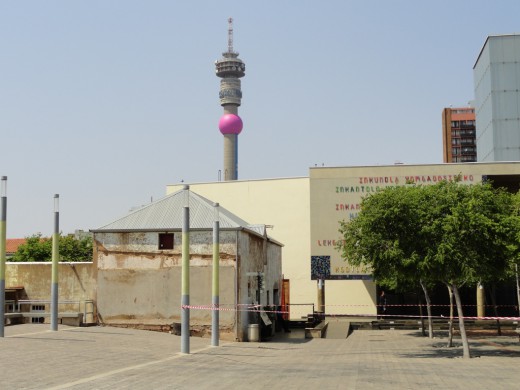
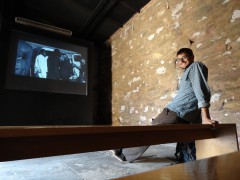

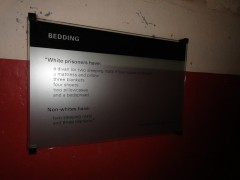


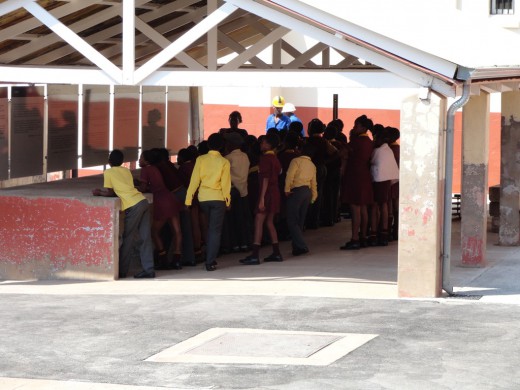
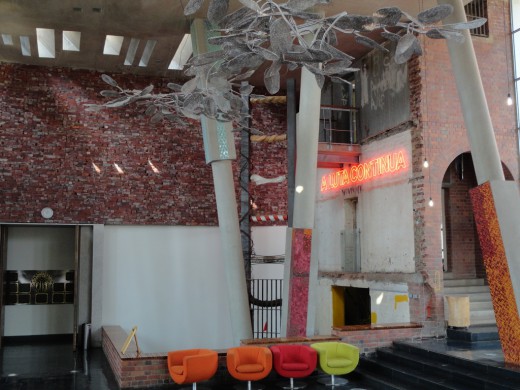



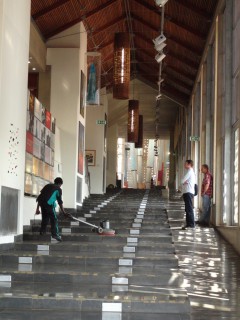

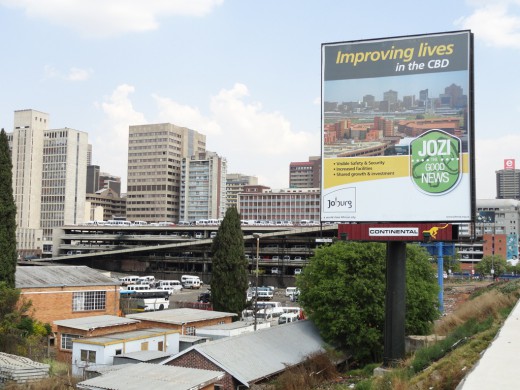
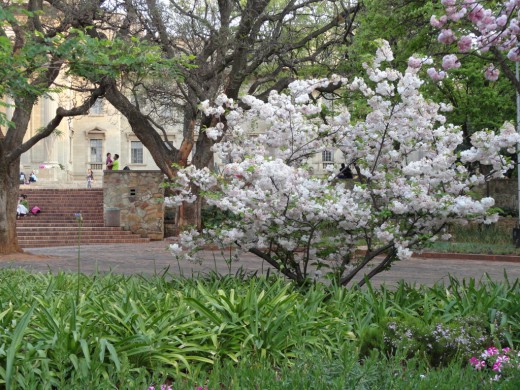
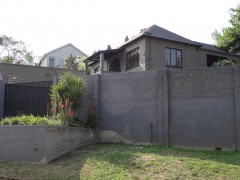
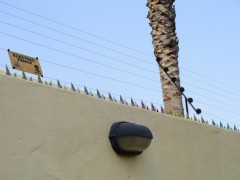
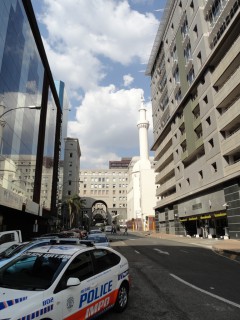
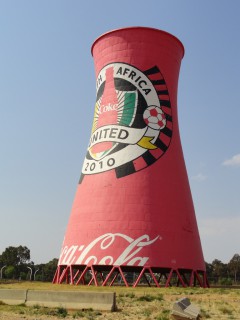
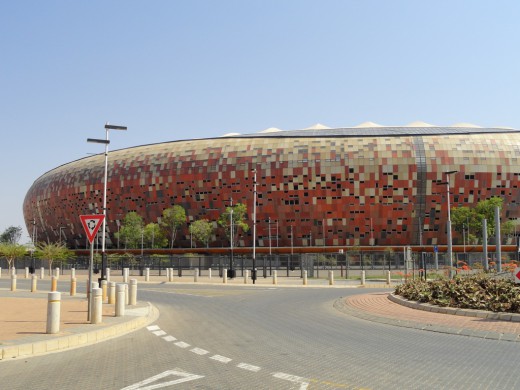
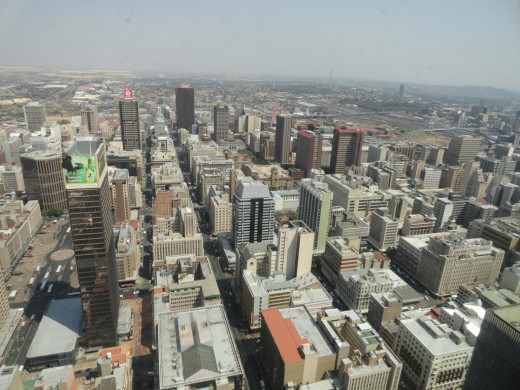
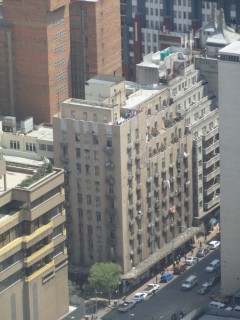

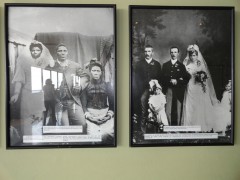
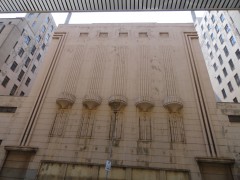
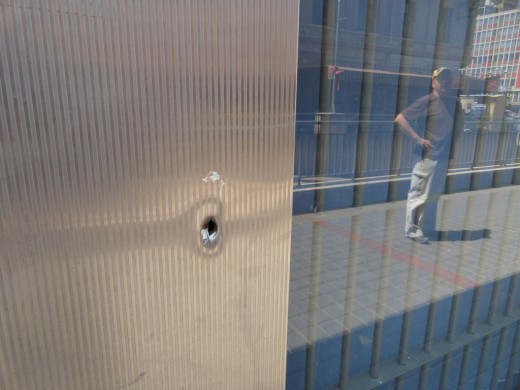
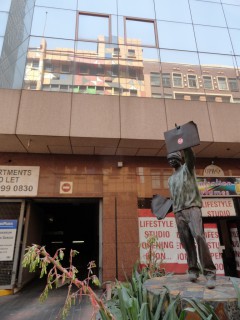
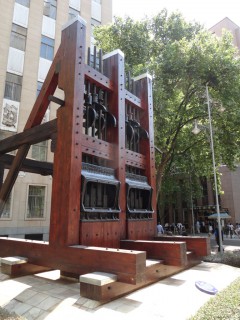
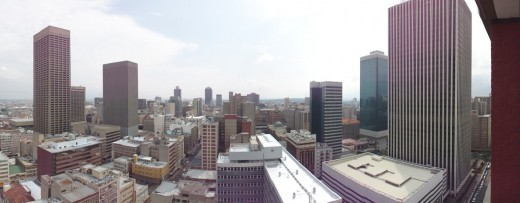

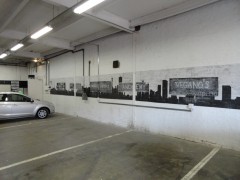

Sonntag, 30. Oktober 2011 17:04
[…] complex of my first host already familiarized me with the security procedures which seem intense even after Johannesburg. I was waiting to be picked up in between two electric fences, a moat-like structure, where the two […]